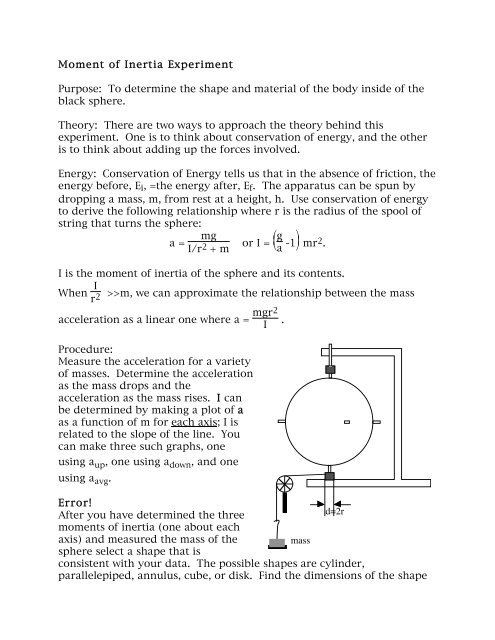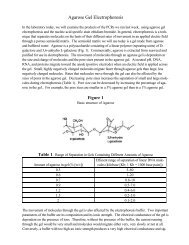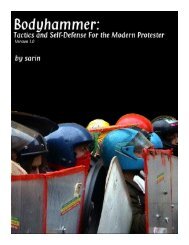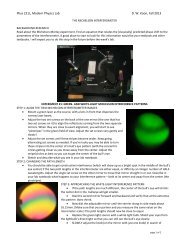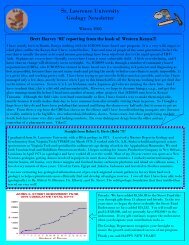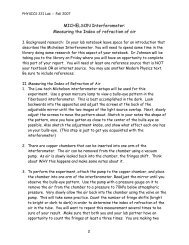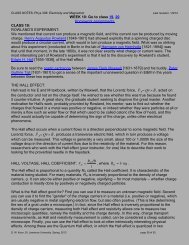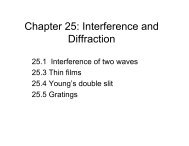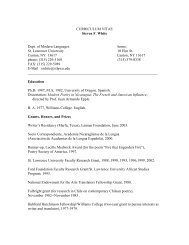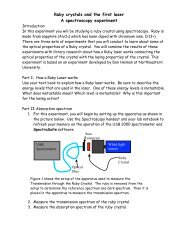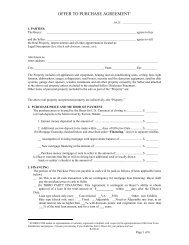Moment of Inertia Experiment Purpose: To determine the shape and ...
Moment of Inertia Experiment Purpose: To determine the shape and ...
Moment of Inertia Experiment Purpose: To determine the shape and ...
You also want an ePaper? Increase the reach of your titles
YUMPU automatically turns print PDFs into web optimized ePapers that Google loves.
<strong>Moment</strong> <strong>of</strong> <strong>Inertia</strong> <strong>Experiment</strong><strong>Purpose</strong>: <strong>To</strong> <strong>determine</strong> <strong>the</strong> <strong>shape</strong> <strong>and</strong> material <strong>of</strong> <strong>the</strong> body inside <strong>of</strong> <strong>the</strong>black sphere.Theory: There are two ways to approach <strong>the</strong> <strong>the</strong>ory behind thisexperiment. One is to think about conservation <strong>of</strong> energy, <strong>and</strong> <strong>the</strong> o<strong>the</strong>ris to think about adding up <strong>the</strong> forces involved.Energy: Conservation <strong>of</strong> Energy tells us that in <strong>the</strong> absence <strong>of</strong> friction, <strong>the</strong>energy before, E i , =<strong>the</strong> energy after, E f . The apparatus can be spun bydropping a mass, m, from rest at a height, h. Use conservation <strong>of</strong> energyto derive <strong>the</strong> following relationship where r is <strong>the</strong> radius <strong>of</strong> <strong>the</strong> spool <strong>of</strong>string that turns <strong>the</strong> sphere:mga =I/r 2 + m or I = ⎝ ⎜⎛ ga -1 ⎠ ⎟⎞ mr2 .I is <strong>the</strong> moment <strong>of</strong> inertia <strong>of</strong> <strong>the</strong> sphere <strong>and</strong> its contents.When Ir2 >>m, we can approximate <strong>the</strong> relationship between <strong>the</strong> massacceleration as a linear one where a = mgr2IProcedure:Measure <strong>the</strong> acceleration for a variety<strong>of</strong> masses. Determine <strong>the</strong> accelerationas <strong>the</strong> mass drops <strong>and</strong> <strong>the</strong>acceleration as <strong>the</strong> mass rises. I canbe <strong>determine</strong>d by making a plot <strong>of</strong> aas a function <strong>of</strong> m for each axis; I isrelated to <strong>the</strong> slope <strong>of</strong> <strong>the</strong> line. Youcan make three such graphs, oneusing a up , one using a down , <strong>and</strong> oneusing a avg .Error!After you have <strong>determine</strong>d <strong>the</strong> threed=2rmoments <strong>of</strong> inertia (one about eachaxis) <strong>and</strong> measured <strong>the</strong> mass <strong>of</strong> <strong>the</strong>masssphere select a <strong>shape</strong> that isconsistent with your data. The possible <strong>shape</strong>s are cylinder,parallelepiped, annulus, cube, or disk. Find <strong>the</strong> dimensions <strong>of</strong> <strong>the</strong> <strong>shape</strong>.
y solving simultaneous equations for <strong>the</strong> moment <strong>of</strong> inertia <strong>of</strong> each axis(subtract <strong>the</strong> moment <strong>of</strong> inertia <strong>of</strong> <strong>the</strong> sphere, I = 2.76 x 10 -3 kgm 2 , from<strong>the</strong> moment <strong>of</strong> inertia about each axis). Then calculate <strong>the</strong> density <strong>of</strong> <strong>the</strong>body <strong>and</strong> compare it to brass (ρ = 8.47 x 10 3 kg/m 3 ) <strong>and</strong> aluminum(ρ = 2.7 x 10 3 kg/m 3 ). If it is not consistent with ei<strong>the</strong>r density, pick a new<strong>shape</strong> <strong>and</strong> start over.Questions:1. Do your plots <strong>of</strong> mass vs. acceleration go through <strong>the</strong> origin. Why orwhy not?2. Is it possible to <strong>determine</strong> all <strong>of</strong> <strong>the</strong> variables for all <strong>of</strong> <strong>the</strong> <strong>shape</strong>s?If not, which <strong>shape</strong>s remain ambiguous? Why?Bonus: Analyze <strong>the</strong> <strong>the</strong>ory involved in thinking about this system usingNewton's laws, ΣF = ma. Include friction, it is significant.The design <strong>of</strong> this experiment is based on a paper by Joe Amato:Amato, Joseph C., Roger E. Williams <strong>and</strong> Hugh Helm, "A 'black box'moment <strong>of</strong> inertia apparatus", Am. J. Phys., 63, 1995, pp. 891-894.


